
Harnessing the power of client feedback
A good client feedback system helps improve both client outcomes and financial sustainability. What does it look like and how does the disability sector stack up?
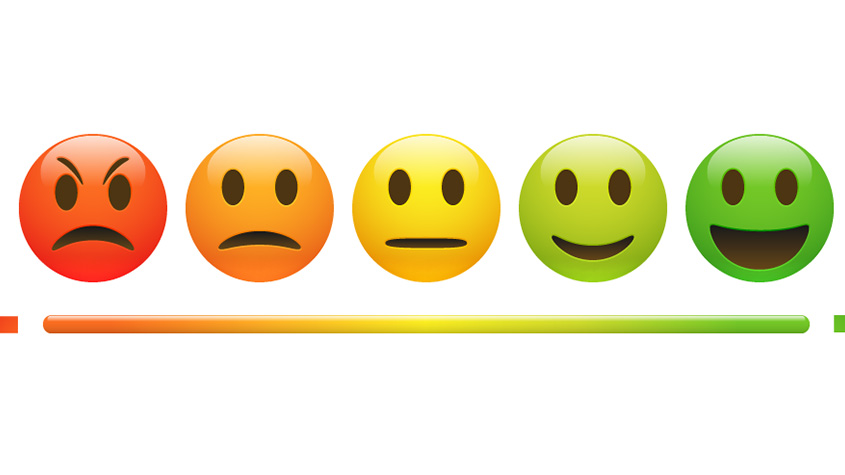
- Client feedback provides valuable fuel for improving both client outcomes and financial sustainability.
- Organisations are often tempted to design complex surveys to learn as much as they can. However, to fuel a cycle of continuous learning and improvement, organisations need a high-velocity model for client feedback: one that collects feedback frequently and disseminates it quickly to those who can act on it.
- The mantra should be ‘simple and frequent’, not ‘complex and rare’.
- Embedding client feedback loops into the way an organisation works requires a significant shift in daily behaviours and operating disciplines. This is a change in culture, and requires concerted, visible senior leadership.
This article is based on excerpts from the full report Harnessing the power of client experience: The collection and use of client feedback in the social sector which has more detail, including case studies of how social purpose organisations have been collecting and using client feedback.
The importance of listening to clients seems obvious. It is difficult for any service to achieve positive outcomes for dissatisfied clients: dissatisfaction reduces engagement, and without engagement, it is hard to have positive impact.
For providers operating in consumer-directed funding environments (such as disability and aged care), client feedback is even more critical. Providers cannot deliver outcomes or achieve financial sustainability without acquiring and retaining clients (i.e. clients need to identify you as a good provider and be satisfied with your service).
A systematic approach to collecting and acting on client feedback is a powerful aid to this goal. But what does a good client feedback system look like? What are the benefits of implementing such a system? And where should you focus to get the most value out of client feedback?
… we expected the disability sector to be one of the most advanced sectors at using client feedback.
This article clarifies the essential features of a good client feedback system and provides a practical roadmap for establishing or improving an existing client feedback system.
We also share findings of a survey into the client feedback systems of some of Australia’s largest and more innovative disability service providers, as we expected the disability sector to be one of the most advanced sectors at using client feedback.
The 18 respondents included established providers with at least $20 million per annum in revenue and smaller providers experiencing triple-digit growth. Collectively, they represent almost $2 billion in annual disability revenue, which is about 40% of total paid NDIS supports in FY18.
Results provide insights into the state of client feedback systems in the disability sector in Australia as well as guidance for effective practice in collecting and using client feedback.
Given the NDIS and the likely introduction of greater competition and choice in other areas of human services, we believe these insights will be useful for organisations across the human services sector.
The value of client feedback
Client feedback provides valuable fuel for improving both client outcomes and financial sustainability.
Empirical evidence from across the corporate sector has shown that satisfied customers are likely to spend more, be more loyal, generate more referrals, and cost less to serve than those who are dissatisfied.[1]
While social purpose organisations are motivated primarily by purpose not profit, there are compelling benefits to generating satisfied clients – for client outcomes and for financial sustainability. (See report for more details.)
A high quality, systematic approach to collecting and acting on client feedback is a powerful boost to this goal.
The organisations we surveyed believe strongly in the benefits of improving client experience (see Figure 1). Almost universally, they believe that a better client experience will not only improve outcomes for their clients, but also improve the sustainability of their organisations. Their beliefs are largely based on qualitative inputs. However, one provider confirmed they have already found a positive correlation between client satisfaction and client retention.
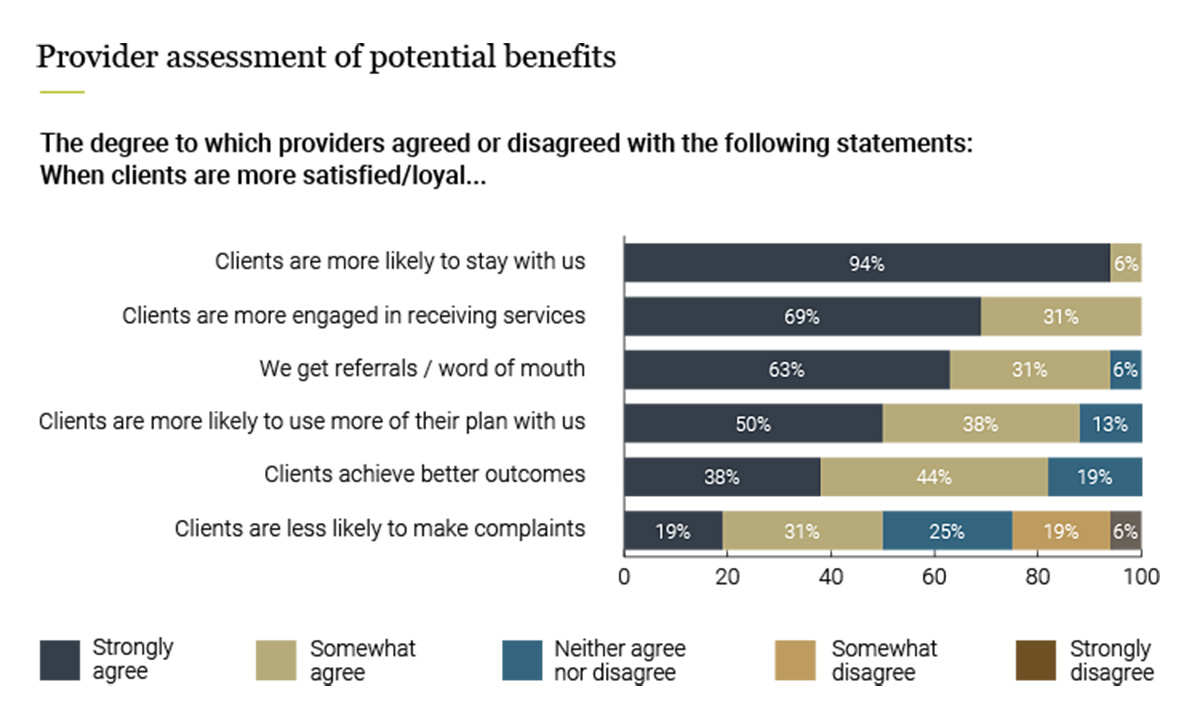
A ‘high-velocity’ model for client feedback
To fuel a cycle of continuous learning and improvement, organisations need a model for client feedback that collects feedback frequently and disseminates it quickly to those who can act on it (see Figure 2).
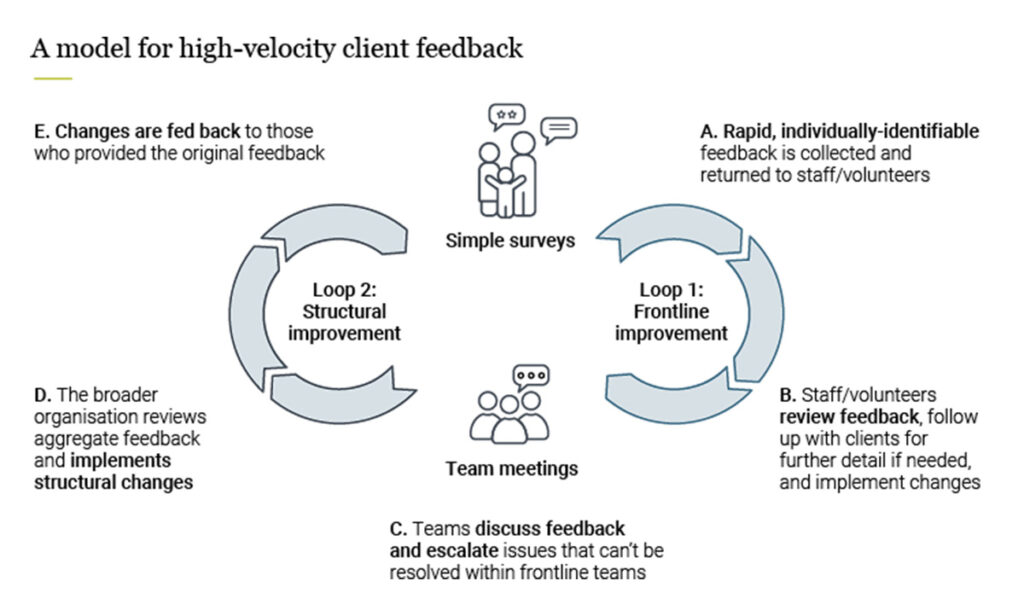
This starts with developing a simple survey: one that is easy to conduct, easy to answer, and will produce actionable insights (A in the diagram). The two key questions used in the Net Promoter System provide a good example. They take the form: “On a scale of 0 to 10, how likely are you to recommend [organisation or service x] to a friend or colleague?” followed by “Why did you give that score?”
This simple combination is deceptively powerful and can generate valuable insight.[2]
The other key design feature of a high-velocity client feedback system is the inclusion of two complementary ‘learning loops’ to listen, learn, and act:
- Loop 1: Frontline improvement.To understand and act on feedback at the front lines (e.g. to improve the way the organisation responds when clients inquire about a service) (B); and
- Loop 2: Structural improvement.To understand, escalate, and act on feedback that requires structural changes and the involvement of functions outside the frontline team (e.g. the redesign of major services, policies, or procedures) (C&D).
The best systems also ‘close the loop’ by communicating back to those who initially provided feedback, to understand the issues more deeply and let them know what actions are being taken (E). This shows responsiveness and encourages further feedback in the future.
Successful organisations embed these feedback loops and the associated ‘listen-learn-act’ disciplines deeply into their day-to-day operations. Two factors make this possible: strong leadership commitment and cultural reinforcement, and robust measurement methodology and systems.
Client feedback systems do not succeed without the genuine commitment of the most senior leaders.
It is important to recognise that technical systems are just one element of enabling an effective client feedback system, and in fact, many organisations are finding they can make do with off-the-shelf survey solutions such as SurveyMonkey. The key challenge for most organisations is not a technical challenge, but rather a cultural one.
Client feedback systems do not succeed without the genuine commitment of the most senior leaders. An effective system requires sustained behaviour change, and without senior commitment, the new disciplines will gradually fall away once the initial burst of energy dissipates. Conversely, powerful changes can take hold and flourish when the most senior leaders consistently make client feedback a priority for the organisation. The best leaders personally role model the disciplines they expect from others, such as making some client call-backs personally.
Benchmarking results from the disability sector
The results from our benchmarking survey on the disability sector’s client feedback systems reveal that the sector is still in the early stages of developing ‘high-velocity’ feedback systems.
Categorising organisations according to how frequently they collect feedback and how quickly they share it with staff shows that only one organisation collects feedback regularly and shares it quickly (see Figure 3).
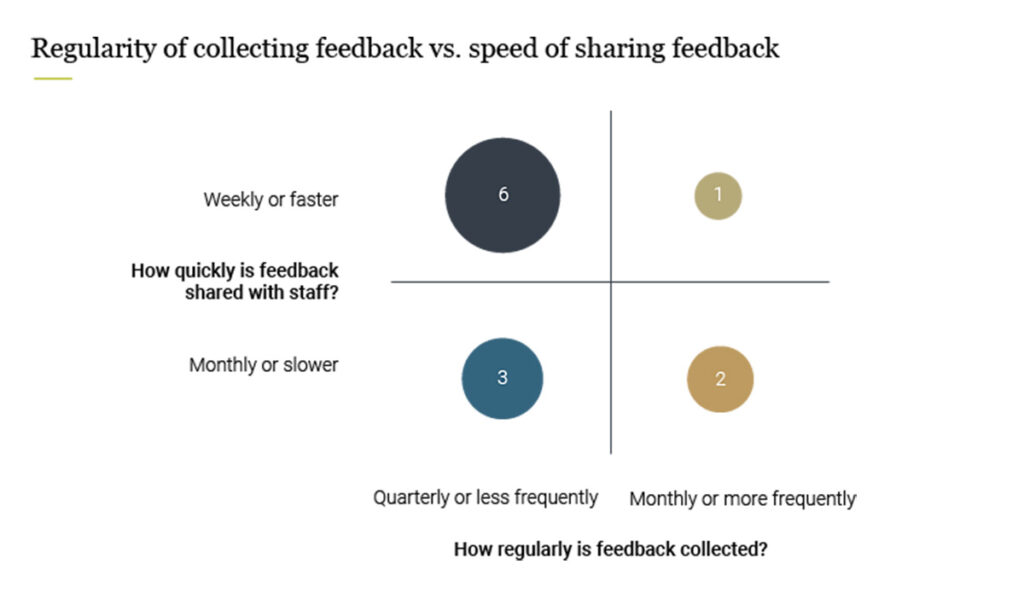
Key findings and areas for improvement
The report calls out four key findings and changes that can enable faster, better insights and greater responsiveness to clients.
1. Increase the frequency of collection and speed of dissemination
Organisations can only learn as quickly as they can get new information through the door and into the right hands.
In our survey, half of all organisations are collecting feedback annually or less frequently making it impossible to identify and address issues quickly. Some organisations are collecting client feedback much more frequently – even weekly (see Figure 4).
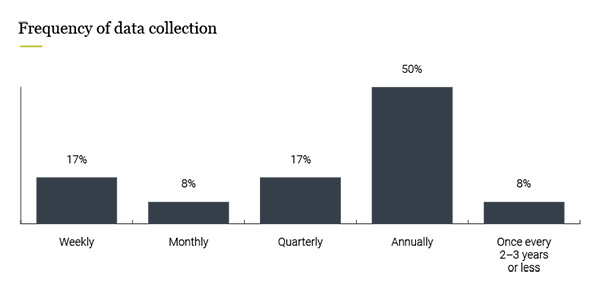
For many organisations, the immediate priority is to improve the frequency of data collection.
For those already collecting data frequently, the next priority is to share it quickly with the staff involved in designing or delivering the experience.
In our survey, only just over half (57%) of the organisations collecting feedback shared it with staff within one week.
Feedback is much easier to understand and to act upon if it relates to recent events. The people involved can remember the specific details, making the information real, not abstract:
“Your client Yasmin said she had to wait three hours to see you yesterday.”
“Oh, that’s right, we were very short-staffed because Kim called in sick and we didn’t have a backup plan.”
Uniting NSW.ACT has an online customer survey platform, ‘Rate Us’, to collect ongoing real-time feedback which consists of seven simple questions:
- One multiple choice question to ask about the individual responding
- Four multiple choice questions on how well Uniting understands their needs, provides the right supports, and gives clients the opportunity to have a say in their supports as well as a Net Promoter Score question
- Two free response questions to unpack what works well and what can be improved
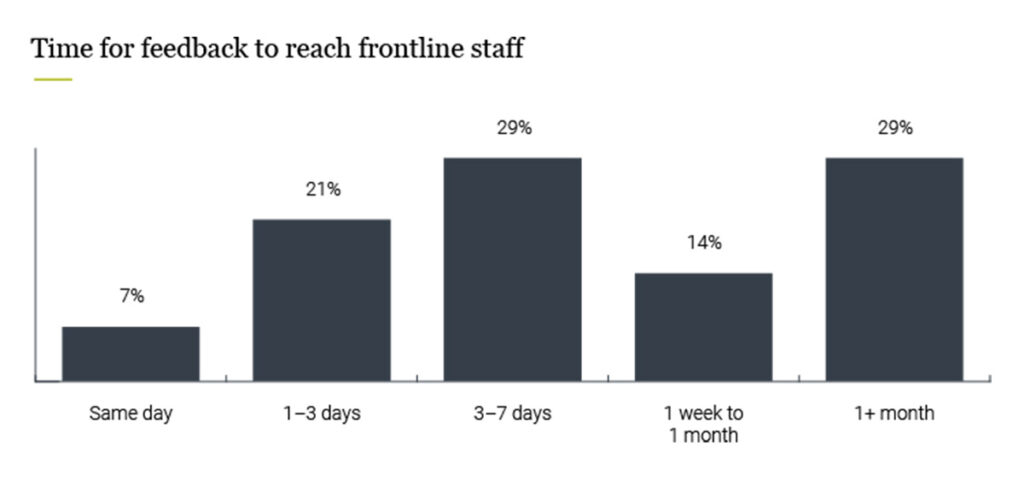
2. Share individual, verbatim feedback, not averages
Seventy percent of the organisations we surveyed shared individual verbatim feedback (see Figure 6). The specificity of the feedback shared directly affects the ability of staff to learn and respond. Without being able to pinpoint feedback to a specific individual or event, it is difficult for staff to know what actions they took that drove what feedback and therefore what they should change.
Imagine, for example, hearing: “Your client Andrew rated his experience yesterday a 2 out of 10. He was upset because his support worker was 45 minutes late, which made him late for work.”
This is far more memorable and actionable than being told, “Our staff had an 80% on-time arrival this week.”
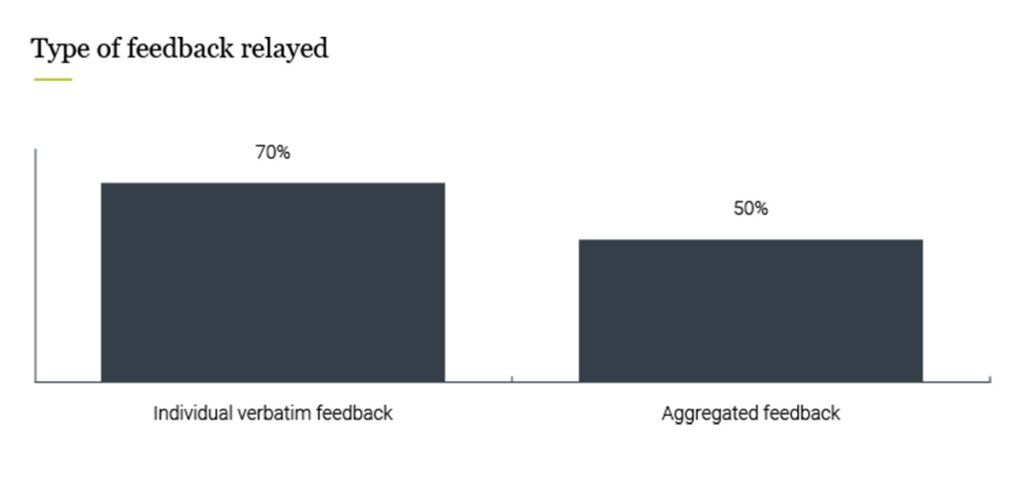
3. Establish routines that help staff take effective action based on the feedback received
To effectively act on feedback, organisations should differentiate between two different categories of feedback: feedback that frontline staff can address, and feedback that requires deeper changes (these are the two ‘loops’ described above). In each category, the relevant staff should receive and discuss the feedback, and receive the help to act on the feedback.
Our research reveals that only about 1 in 5 organisations (21%) have their frontline staff engage with client feedback and provide coaching on how to address the feedback (see Figure 7).
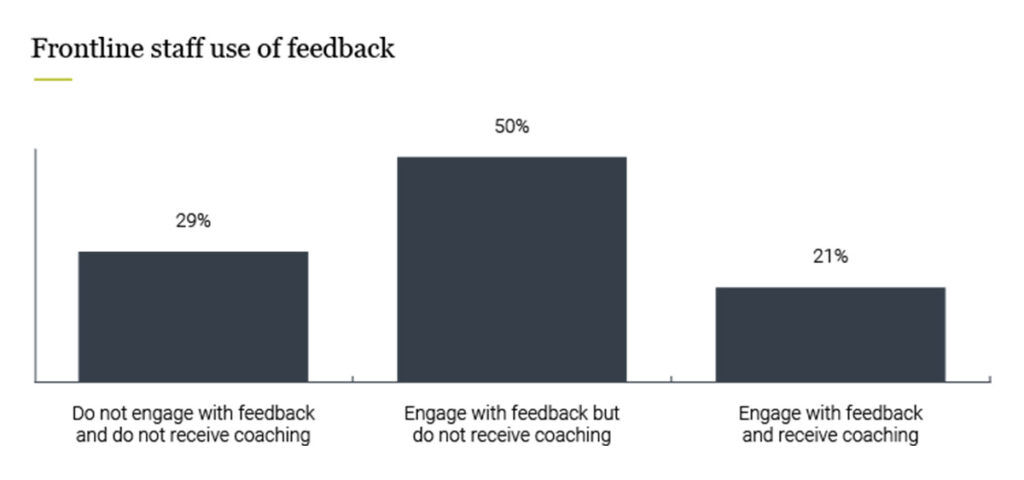
For feedback requiring changes beyond the front line, a cross-organisational approach is required that brings together people from the relevant teams. Indeed, helping each part of your organisation understand the role it plays in the overall client experience is an important step in building a client-centric culture.
Our research shows that while almost all organisations (85%) report getting middle management to review and act on feedback, the involvement of other groups is far from universal (see Figure 8). The involvement of back office staff is especially uncommon (only 15% of our sample). This is a missed opportunity because back office activities (such as billing and invoicing) can shape the client experience as much as what happens in direct client interactions.
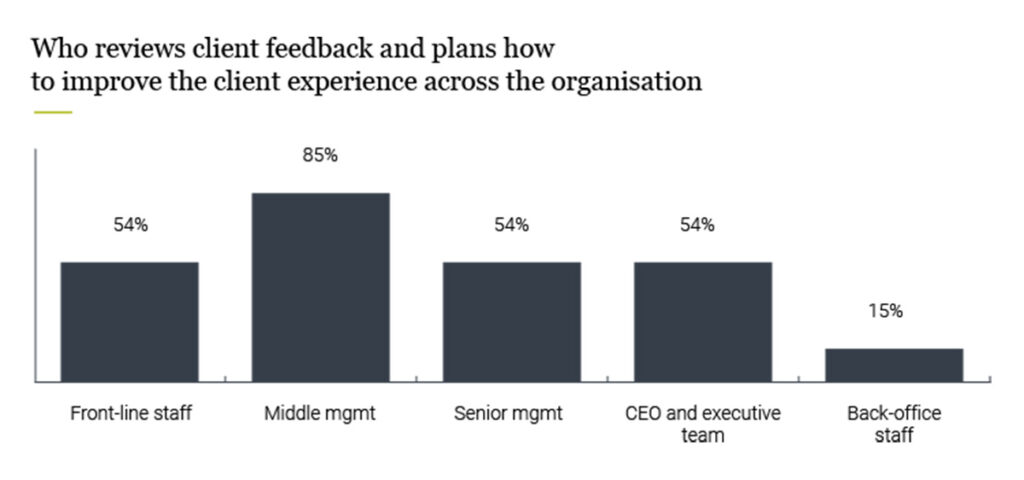
4. Close the loop with the clients who provided the feedback
It is valuable to communicate back to at least some of the clients who provided specific feedback – especially those who provided very negative comments. ‘Closing the loop’ shows clients that you have heard their concerns and creates an opportunity to test potential solutions. It also helps staff hear firsthand about the impact a poor service experience can have.
When done well, this follow-up process can convert even the most critical clients into advocates.
Taking action
Client feedback can lead to a wide array of improvements in service design and delivery – from inexpensive and obvious refinements to fundamental changes requiring real effort. While sometimes the feedback system uncovers unexpected insights, some of the greatest benefits come from acting – at last! – on issues which were already well known but somehow went unaddressed.
We collected examples of improvement areas identified by organisations in the disability sector (see below).
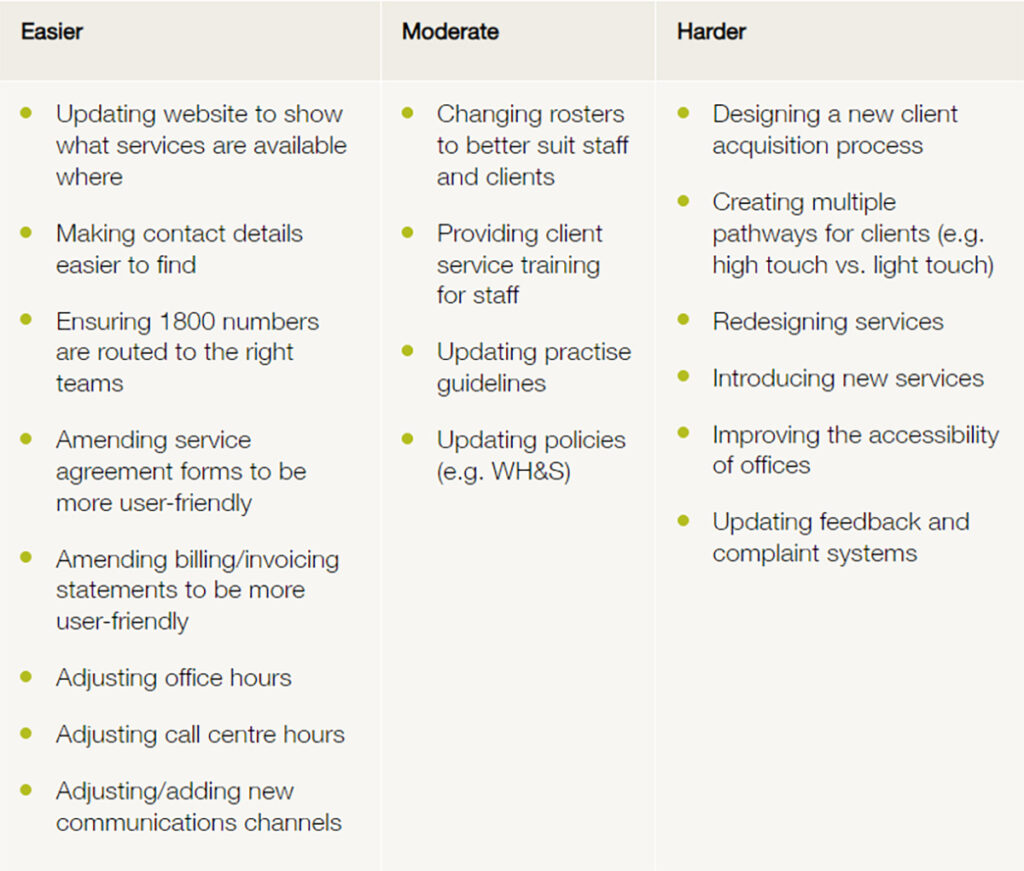
A practical roadmap for any organisation seeking to improve their use of client feedback
For organisations wanting to improve their use of client feedback, it is important to remember that the core of the system is simple: systematic, high-velocity ‘listen-learn-act’ loops. This involves developing a simple set of questions that can be administered frequently, distributing results to relevant staff in a timely fashion, and providing coaching or other support to assist staff to act on the feedback immediately.
How to start?
1. Make client feedback a priority
Engage senior leadership in making client feedback a top priority for the organisation. Articulate why it matters to the organisation – whether it’s about improving client outcomes or financial sustainability – and role-model a commitment to listening, learning, and acting on client feedback.
2. Decide what to measure
What parts of the client experience matter most to your clients? Try to find the parts that either disappoint clients or generate strong positive reactions. Perhaps the initial inquiry and sign-up process is cumbersome, or perhaps staff availability is an issue. Understanding the opportunities to create lasting positive impressions is also valuable. Key moments that matter are usually well known by staff but can be identified by examining existing data such as letters of complaint or appreciation. (Note: this may differ by service or cohort, and you might want to choose a single service or cohort to start.)
Another lens to consider is the experiences that matter most to your internal operations (e.g. where are the bulk of your costs or which steps take the most time and effort). Chances are, areas that are clunky internally are also clunky from your clients’ perspective. Fixing them can make life better for everyone.
3. Decide how to measure
Keep it simple. What is the simplest set of questions you can ask to get started? Have you selected both a quantitative question and a qualitative question to understand the reason for the rating?
4. Decide how to engage staff in the process
Consider engaging staff early to help design the survey and the specific feedback routines they will participate in to review and act on feedback. This will encourage buy-in and ownership, and ensure your feedback system is practical.
Find ways to make tangible actions visible early, so staff can see that management’s commitment to act on the feedback is real. Celebrate the contributions made by people who are making a difference.
Client feedback is a powerful and practical source of insight for any organisation aiming to improve the experience it delivers to its clients. A set of simple disciplines and routines can generate very significant uplift in client experience once an organisation gets into a regular rhythm of hearing and acting upon what clients have to say. The mantra should be ‘simple and frequent’, not ‘complex and rare’.
Start small, be practical, and learn what works for you and your clients.
Ultimately, embedding client feedback loops into the way an organisation works requires a significant shift in daily behaviours and operating disciplines. This is a change in culture, and requires concerted, visible senior leadership. Organisations which become truly effective at using client feedback are those whose senior leaders make it a clear priority. These leaders have a genuine desire to learn and improve, and are willing to stay the course even when progress seems slow.
Start small, be practical, and learn what works for you and your clients.
About the report
The report, Harnessing the power of client experience: The collection and use of client feedback in the social sector is a collaboration between Social Ventures Australia and the Chris and Kathy Harrop Endowment, who commissioned and generously funded this work.
Authors: Diana Ferner and Chris Harrop
Notes
- Bain & Company, The Economics of Loyalty.
- Note that the score is valuable not so much to ‘rate’ performance, but rather to provide a yardstick for progress over time, and to help clients express their feelings clearly. A client may say they are “very happy”, but a 10 out of 10 is unambiguously positive and universally understood.




